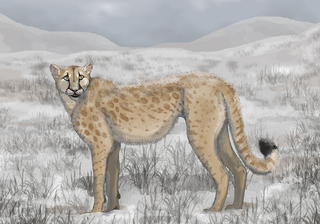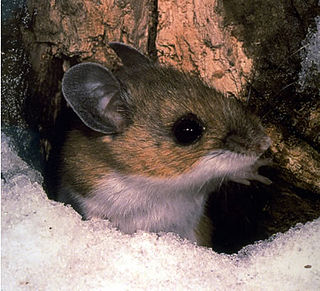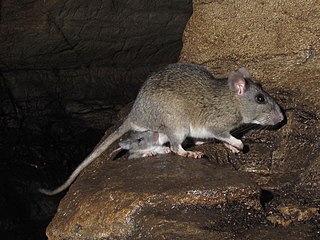
The desert woodrat is a species of pack rat native to desert regions of western North America.

The American cheetah is either of two feline species of the extinct genus Miracinonyx, endemic to North America during the Pleistocene epoch and morphologically similar to the modern cheetah. These cats were originally known from fragments of skeletons, but nearly complete skeletons have been recovered from Natural Trap Cave in northern Wyoming.

The Neotominae are a subfamily of the family Cricetidae. They consist of four tribes, 16 genera, and many species of New World rats and mice, predominantly found in North America. Among them are the well-known deer mice, white-footed mice, packrats, and grasshopper mice.

The eastern woodrat, also known as the Florida woodrat or bush rat, is a pack rat native to the central and Eastern United States. It constructs large dens that may serve as nests for many generations and stores food in outlying caches for the winter. While widespread and not uncommon, it has declined or disappeared in several areas.

The Mexican woodrat is a medium-sized pack rat.

The Allegheny woodrat, is a species of "pack rat" in the genus Neotoma. Once believed to be a subspecies of the eastern woodrat, extensive DNA analysis has proven it to be a distinct species.

Findley's myotis is a species of vesper bat. It is found only on the Tres Marías Islands off the west coast of Mexico.

The white-throated woodrat is a species of rodent in the family Cricetidae. It is found from central Mexico north to Utah and Colorado in the United States. It is primarily a western species in the United States, extending from central Texas west to southeastern California. Populations east of the Rio Grande in New Mexico and Trans-Pecos Texas, previously considered to be variants of the white-throated woodrat, have since 1988 been assigned to the white-toothed woodrat.

The bushy-tailed woodrat, or packrat is a species of rodent in the family Cricetidae found in Canada and the United States. Its natural habitats are boreal forests, temperate forests, dry savanna, temperate shrubland, and temperate grassland.
Nelson's woodrat is a species of rodent in the family Cricetidae. It is endemic to Mexico, where it is known only from the eastern slopes of the volcanoes Orizaba and Cofre de Perote. Due to the small geographic range, isolation, and low population, the Nelson's woodrat has a higher risk for extinction. The distribution and population sizes are small. The population exists in geographic isolation, which prevents gene flow

Nothrotheriops is a genus of Pleistocene ground sloth found in North America, from what is now central Mexico to the southern United States. This genus of bear-sized xenarthran was related to the much larger, and far more famous Megatherium, although it has recently been placed in a different family, Nothrotheriidae. The best known species, N. shastensis, is also called the Shasta ground sloth.
Burnet Cave is an important archaeological and paleontological site located in Eddy County, New Mexico, United States within the Guadalupe Mountains.

A pack rat or packrat, also called a woodrat or trade rat, can be any of the species in the North and Central American rodent genus Neotoma. Pack rats have a rat-like appearance, with long tails, large ears, and large, black eyes. Pack rats are noticeably larger than deer mice, harvest mice, and grasshopper mice, and are usually somewhat larger than cotton rats.

The Haile Quarry or Haile sites are an Early Miocene and Pleistocene assemblage of vertebrate fossils located in the Haile quarries, Alachua County, northern Florida. The assemblage was discovered during phosphate mining, which began in the late 1940s. Haile sites are found in the Alachua Formation. Two sites within the Ocala Limestone yielded Upper Eocene Valvatida and mollusks.

Arthur H. Harris is an American mammalogist and paleontologist.












